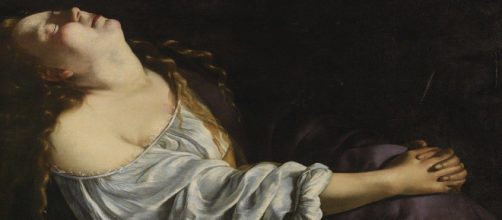This is a case of being extremely late to the party. First, the news: London's National Gallery has launched a blockbuster, a 129-item picture show by Baroque-era painter Artemesia Gentileschi, whose works have never been seen in England before.
A star is re-born
In a review of the National Gallery show titled "Artemesia," ArtDaily observed that identifying the painter by a single name, like some pop star, befits a woman the New York Times refers to as "the most celebrated female artist of the 17th century." And the New Yorker magazine review recalled that even in her lifetime, she was internationally celebrated.
Not a newbie
And while her star dimmed after she died, as did all Baroque-era painters, including Caravaggio, the New Yorker argued that her star gleamed brightly when her work showed at the Metropolitan Museum of Art in 2001. I'd argue that her star sparkled long before. (More about that in a moment). Yet, according to The Guardian review by 21-year veteran art critic Jonathan Jones, you'd think Artemesia was new to fame – "a forgotten genius," he called her, and getting the National Gallery to show a "heroic resurrection."
Forgotten genius?
How forgotten was she? Consider the six books about her beginning in 1862 with George Eliot's Romola, and the six theater productions, including Wendy Wasserman's The Heidi Chronicles in 1988, and two TV shows, including the series Painted Lady in 1997, and the feature film "Artemesia" in 1997.
Where have you been all this time, Jonathan Jones?
Playing catch-up
It's not that Jones' art-writing is wanting. It isn't. It sings. For example, in his review, he called the gory painting of Judith Beheading Holofernes, so driven by memories of a rape she suffered at the age of 17, "a selfie from hell." It's just that his review gives the impression that Artemesia is England's discovery.
Did he forget that as far back as 1979, Germaine Greer hailed her ability to gain recognition when other female artists couldn't, as "The Magnificent Exception"?
Working mother
It's worth mentioning that along with her success as a painter, Artemesia bore five children. So, when she told one of her patrons, Don Antonio Ruffo, "I will show your Illustrious Lordship what a woman can do," she wasn't just blowing smoke.
Agree to disagree
This isn't the first time I've disagreed with Jones. Writing about Edvard Munch's The Scream, he said that howling came from Munch's angst, and in that sense, was the perfect sign of our times. Munch would have balked at that. In his diary in 1892, he said the painting isn't about his being upset, but about Mother Nature being upset – hence the angry red, swirling sky. It's as if Munch saw climate change coming.
Wishful thinking
Jones also fell for Damien Hirst's over the top sculpture show in Venice. He loved it so much that he compared it to another Hirst show he loved - the dead tiger shark floating in formaldehyde. As inexplicable as I found his enthusiasm for both these shows, I have always admired his ability to write memorably about art, i.e., calling Artemesia's painting of a woman taking a man's head off "a selfie from hell." I wish I'd written that.


